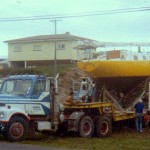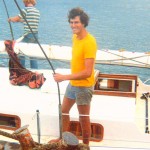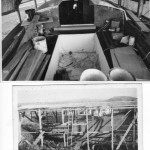Occasionally I get melancholic about old boats, especially the one I built in the early seventies when I was in my twenties. Wild Honey launched the Admiral and myself into a fun ten years of cruising. It was as basic as you get, since we never had a ship’s chandler to shop from, but she took us around the Pacific and up and down Northland’s coast many times. I’ve heard some stories about what happened to her, including one preposterous story that it was professionally built. That was in a fishing magazine. Here’s an unedited version of one aspect, the launching. It was published in Cruising Helmsman, last year in a slightly different form. I don’t usually blog big pieces for fear of boring you to death, but this is an attempt at a humourous ditty. Cheers and good luck.
Building My First Boat: Inspirations and Practicalities
When the first hairs grew from my chin, I developed an irresistible urge to own a boat. The desire to go sailing was innate. My psyche was affected by living on a sandy peninsula near the ocean and harbour. It had nothing to do with needs – this was an unstoppable urge to construct a craft that would take me past the shores of my playground.
The first urge developed when the air was dank with salt spray and my equally motivated mates and I conspired to set sail, in a metaphorical sense. Through employing eco principles before they became fashionable, we decided to build a craft that would be biodegradable if left long enough on the foreshore.
At our age, financial insufficiency inspired creativity. An apple box rescued from Dad’s fire stack was the kindle of our first boat. The boat was made of untreated pine like a Turkish Gulet boat but without the same graceful lines or speed. A maritime architect would have been challenged to create a viable design based on the apple box concept. The blunt bow countered the established idea of a fine entry. Athwart ships and directional stability would be a challenge for the kinesthetic skills of the helmsman. The idea of constructing a catamaran-style stable platform did not occur to us. However another issue would override these design flaws.
We caulked with blue plasticine the large cracks in the apple box, originally designed for ventilation for respiring apples. It never occurred to us that this adventure would influence our later lives when he would become a cool store engineer and I would become a cruising enthusiast and would occasionally write boating stories.
As the most gullible crewmember, I was promoted to rank of skipper for the maiden voyage. Soon after launching and before I had the chance to discover the effects of the aforementioned two stability factors, I discovered the negative effect of just 250mm of positive water pressure on our low-tech caulking. The now renamed sailing vessel Sieve sank a few metres from the shore. After this disappointment our yen for boating took a literal dive, so we took up terrestrial hobbies like sand surfing and constructing hideouts overlooking the harbour entrance instead.
Only ten years later, I needed a sink into which I could pour my earnings. While my mates were purchasing property or using the big silver birds for their overseas trips, I became consumed by the desire to have a real boat. This was an intense, focused time of youth when all well-intentioned and intelligent advice from adults is spurned. At this stage motivation was fired by want, not need. Any deficiencies in our knowledge base would be removed by research and the brain was a blotter for information.
My island country of New Zealand was separated from any other nation by almost a thousand miles of ocean. If I could build a real boat powered by the wind, like a kiwi explorer before me, I could say I had knocked the bastard off. A real boat would also be an overseas ticket and accommodation rolled into one. My dream of a seaworthy yacht creaming north on lazy ocean swells was too irresistible to ignore.
At the time, designers were supplying full size plans of boats to satisfy the lust of boating neophytes. No prior experience in small craft construction was required. Robyn Lee Graham’s circumnavigation on the Dove was showing in the movies, some years after the inspirational 1966 surf movie The Endless Summer had prompted surfers to search for the perfect wave. Every town had a dreamer building a boat, and against the advice of my parents, I decided to build. My mother used to worry, “What do you know about yacht construction, boy? You haven’t even built a letter box!” These concerns were conveniently crushed by youthful impulsiveness, which bode well for the ‘just do it!’ philosophy needed to kick-start such a complex project. Typically, lack of hindsight is extremely useful when you are in your early 20s. If I knew the effort required for such a project, it may never have got off the launching pad.
I began the journey after a talk with an amateur boat builder who showed me through his almost-finished project. It was a heavy displacement ten metre sailing vessel, with sufficient below-decks headroom to prevent bloodying my scalp (I am 6 feet 4 inches tall). I could see this design had six berths, and was quite capable of offshore sailing. My vision was clouded by images of bikini-clad girls lounging above and below decks. The boat builder told me, as a glaze-eyed visitor, to start the project by purchasing plans and a set of frames. Avoiding frame lofting would circumvent a technical stage, and allow immediate hanging of frames. I immediately purchased a set of frames and plans of that very same design, as I had visions of a blue horizon, despite having done little research. This one had the headroom, and had six berths, which was what mattered to a hotheaded 21 year old.
The designer had supplied me with a shopping list of the hardware necessary to build the boat. Several months later, although no tangible boat hull was in sight, I had a collection of shiny hardware and some tools for the fitting out. These were useful for a virtual construction, and kept the project viable, until a physical site for assembling was found. Apart from large items, stuff was transported on my 350cc motorbike bit by bit. Even heavy pieces of lead were mute passengers on the 100-mile trip from the foundry to home.
I had no idea of where I could build the imaginary boat, and with the frames in storage, I toured the country talking to other amateur boat builders. Those who had been regarded as eccentric by their suffering neighbours inspired me.
I found a man called Bruce building his boat on an elevated sand dune, which had to-kill-for-views. He turned out to be my guru. At the time he was about to dismantle his large open sided construction that supported his boat’s hull frames – these designs were built upright. For just $100 I took his pre-loved building frame off his hands. Furthermore, Bruce’s neighbour had a plot of sand dune on which I could construct my boat and gaze at the Pacific Ocean. In return for his building frame, I painted his holiday home one summer. This was a good deal and one that satisfied both parties. Bruce was my mentor, and also lent me tools. After Bruce launched his boat, Marion (at that time my girlfriend, now my wife) and I helped crew it to Fiji – but that is a story in itself.
Curiously, the shots on the right are the only ones taken, one by a friend Claziena who was visiting, and another by Bruce, my mentor from next door. The bottom shot below shows the cage prior to plastering. (Yes this has let the cat out of the bag re construction).
I learnt about building permits when an irate inspector discovered my motley group of friends lifting up the $100 building frame, which was not a good look for the beach suburbs. The building inspector asked me, as the leader, to report to his office. Meanwhile the large edifice, looking very much like a flimsy roof on stick supports, was to become a landmark of the area and provide inspiration for other wannabe boat builders and cruisers. Luckily, I was excused from the considerable expense of being required to have a permit on the grounds that the temporary construction had no foundations. The frames were hung and the tangible shape of a graceful ocean-going yacht took form. At that age I often worked on site until midnight, relishing the completion of each incremental job.

A secure hut was necessary to store my tools and materials. The hut became pretty hot in the sun because it was made of corrugated steel. The first piece of woodwork I made was the rudder, and it was required to be completely dry before being encased in fiberglass. The rudder assumed a permanent curve while propped up against the inside of the hot wall, due to the difference in grain direction of two wood layers. Left as it was, it may have given the boat a permanent starboard bias. On the advice of another boat builder, I reshaped the rudder to prevent this from occurring, and then inserted some horizontal hardwood stringers that locked it into proper shape. The first lesson I learnt was to make sure dry timber is used. I learnt by reading, talking to my mentor Bruce, and by experimenting.
Although the boat was built to a budget, it also had to be a strong and safe seagoing vessel. Previous amateur boat builders had become legends for their ingenuity in economising, and I aspired to emulate their craft.
Using the same philosophy, Bruce had completed his boat next door, all the time providing a sort of apprenticeship training to me. He was the master of improvisation and inventiveness. Bruce ran marathons, and once while running past the local tip (at a time when there were no access restrictions), he discovered hundreds of metres of rejected mahogany door flashing. The salvaged strips provided perfect laminating timber for varnished cabin top beams, a tiller and fine cabinetwork.
Three years after hanging the frames, the backyard project was ready to launch. However, non-celestial events conspired to prevent my launching. Before construction I obtained permission to move my boat after it was built across my neighbour’s property. It was the only practical way out. Ominously, a new owner was now landscaping and preparing to barricade his property with a fence. This was starting to look like an episode of The Great Escape. Luckily, my neighbours left during the week. Since the escape route was on a slope, I rushed in a trucking firm to bulldoze their land. A large flat trench was reinforced with stone base to prevent a crane and truck sinking into sand. The script did not run to plan, and there were delays and technical problems. At three o’clock on a Friday afternoon, just hours before the owners returned to their remodeled property, my proud project was carried out on the boat trailer, grinding into the lawn and garden. A week later, the property had been returned to normal, ready for fencing. The launching marked the beginning of a ten-year period of sailing through coastal and tropical waters.
In retrospect, the hurried exit via the neighbour’s property sounds like an exercise in how to attract litigation, but the event ended amicably, the author having returned the neighbour’s land to a better state than before the exit. Later, the author built several houses then swapped one for a boat in which his family (wife and two daughters) lived for ten years, circumnavigating the world.



Brilliant.
Inspirational.
Do people still do this sort of thing nowadays in NZ?
Wild Honey (no relation to Wild Bird) was a ferro cement boat and they were the rage back then when it was the only way one could afford to go cruising. There were several ferro boats being built in most towns, and it got hundreds of people on the water, and these boats are still being used. It think with more money sloshing around, boats are being bought, not built. Especially at their fantastic prices these days, compared to the cost of building one.
we remember reading one of your articles in Cruising Helmsman about repairing a last in the Solomon’s??? We are still in Australia playing in the Sundeer and working.
Brett & Debbie
Hi Brett Yes, I repaired the wooden mast in Sydney when we returned from Solomons from memory. We have Wild Bird in Bay of Islands, NZ now. All well. Cheers Colin
Hi Colin , we owned Wild Honey between 2010 and 2019.
Would you like some pictures. I wrote a number of articles for Fishing Coast to Coast magazine. The column was called ‘Living on Wild Honey.
She was in a bad way when we bought her and she needed a lot of love and money.
I was fairly pleased with the job we did.
Cheers Richard